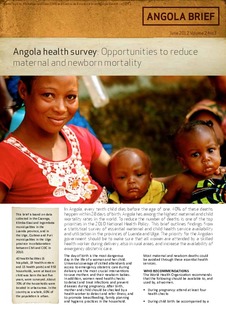| dc.contributor.author | Sjursen, Ingrid Hoem | |
| dc.date.accessioned | 2018-01-04T08:20:29Z | |
| dc.date.available | 2018-01-04T08:20:29Z | |
| dc.date.issued | 2012-06-01 | |
| dc.identifier | oai:www.cmi.no:4492 | |
| dc.identifier.citation | Bergen: Chr. Michelsen Institute (Angola Brief vol. 2 no. 3) 4 p. | |
| dc.identifier.issn | 1892-3933 | |
| dc.identifier.uri | http://hdl.handle.net/11250/2475113 | |
| dc.description.abstract | In Angola, every tenth child dies before the age of one. 40% of these deaths happen within 28 days of birth. Angola has among the highest maternal and child mortality rates in the world. To reduce the number of deaths is one of the top priorities in the 2010 National Health Policy.
This brief outlines findings from a statistical survey of essential maternal and child health service availability and utilization in the provinces of Luanda and Uíge. The priority for the Angolan government should be to make sure that all women are attended by a skilled health worker during delivery, also in rural areas, and increase the availability of emergency obstetric care. | |
| dc.language.iso | eng | |
| dc.publisher | Chr. Michelsen Institute | |
| dc.relation | Angola Brief | |
| dc.relation | 3 | |
| dc.relation.ispartof | Angola Brief | |
| dc.relation.ispartofseries | Angola Brief vol. 2 no. 3 | |
| dc.relation.uri | https://www.cmi.no/publications/4492-angola-health-survey | |
| dc.subject | Angola | |
| dc.title | Angola health survey: Opportunities to reduce maternal and newborn mortality | |
| dc.type | Report | |
